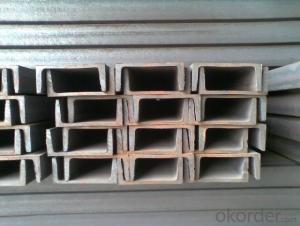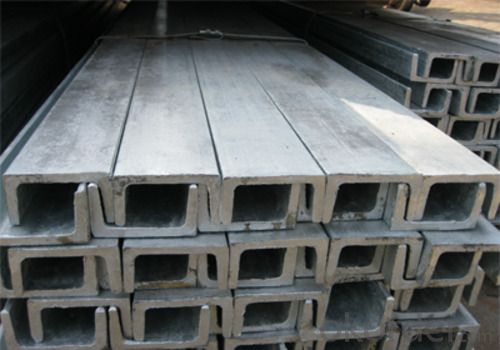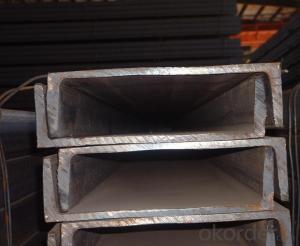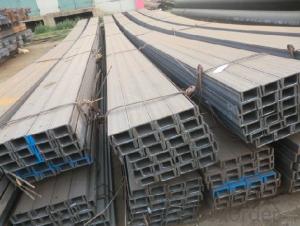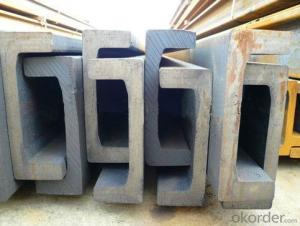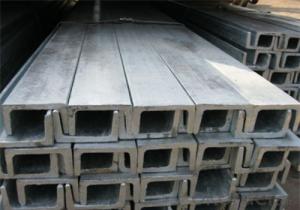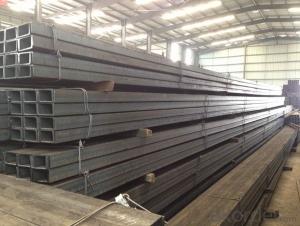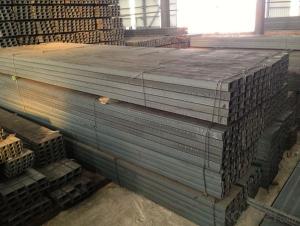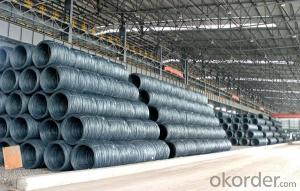Channel Bar Hot Rolled Mild U Channel Steel Bars
- Loading Port:
- Tianjin
- Payment Terms:
- TT or LC
- Min Order Qty:
- 100 m.t.
- Supply Capability:
- 35000 m.t./month
OKorder Service Pledge
OKorder Financial Service
You Might Also Like
OKorder is offering Channel Bar Hot Rolled Mild U Channel Steel Bars at great prices with worldwide shipping. Our supplier is a world-class manufacturer of steel, with our products utilized the world over. OKorder annually supplies products to African, South American and Asian markets. We provide quotations within 24 hours of receiving an inquiry and guarantee competitive prices.
Product Applications:
Channel Bar Hot Rolled Mild U Channel Steel Bars are ideal for structural applications and are widely used in the construction of buildings and bridges, and the manufacturing, petrochemical, and transportation industries.
Product Advantages:
OKorder's Channel Bar Hot Rolled Mild U Channel Steel Bars are durable, strong, and wide variety of sizes.
Main Product Features:
· Premium quality
· Prompt delivery & seaworthy packing (30 days after receiving deposit)
· Can be recycled and reused
· Mill test certification
· Professional Service
· Competitive pricing
Product Specifications:
Manufacture: Hot rolled
Grade: Q195 – 235
Certificates: ISO, SGS, BV, CIQ
Length: 6m – 12m, as per customer request
Packaging: Export packing, nude packing, bundled
Trademark | Rank | Chemical composition (quality score) % | |||||
C | Si | Mn | S | P | |||
≤ | ≤ | ≤ | |||||
Q235 | A | 0.14-0.22 | 0.30 | 0.30-0.65 | 0.050 | 0.045 | |
Q235 | B | 0.12-0.20 | 0.30 | 0.30-0.70 | 0.045 | 0.045 | |
Trademark | Rank | Pulling Test | |||||
Bend PointΔs/Mpa | Tensile Strength | Elongation Ratioδ5% | |||||
Thickness (Diameter) /MM | Thickness (Diameter) /MM | ||||||
≤16 | 16-40 | ≤16 | 16-40 | ||||
≥ | ≥ | ||||||
Q235 | A | 235 | 225 | 375-500 | 26 | 25 | |
Q235 | B | 235 | 225 | 375-500 | 26 | 25 | |
| JIS STANDARD CHANNEL | ||||||
| SIZE(MM) | h(mm) | b(mm) | s(mm) | t(mm) | kg/m | length |
| 50x25x3x6 | 50 | 25 | 3 | 6 | 2.37 | 6m,12m |
| 75X40x3.8x7 | 75 | 40 | 3.8 | 7 | 5.3 | 6m,12m |
| 75X40x4x7 | 75 | 40 | 4 | 7 | 5.6 | 6m,12m |
| 75X40x4.5x7 | 75 | 40 | 4.5 | 7 | 5.85 | 6m,12m |
| 75X40x5x7 | 75 | 40 | 5 | 7 | 6.92 | 6m,12m |
| 100X50x3.8x6 | 100 | 50 | 3.8 | 6 | 7.3 | 6m,12m |
| 100X50x4.2x6 | 100 | 50 | 4.2 | 6 | 8.03 | 6m,12m |
| 100X50x4.5x7.5 | 100 | 50 | 4.5 | 7.5 | 8.97 | 6m,12m |
| 100X50x5x7.5 | 100 | 50 | 5 | 7.5 | 9.36 | 6m,12m |
| 125X65x5.2x6.8 | 125 | 65 | 5.2 | 6.8 | 11.66 | 6m,12m |
| 125X65x5.3x6.8 | 125 | 65 | 5.3 | 6.8 | 12.17 | 6m,12m |
| 125X65x5.5x8 | 125 | 65 | 5.5 | 8 | 12.91 | 6m,12m |
| 125X65x6x8 | 125 | 65 | 6 | 8 | 13.4 | 6m,12m |
| 150x75x5.5x7.3 | 150 | 75 | 5.5 | 7.3 | 14.66 | 6m,12m |
| 150x75x5.7x10 | 150 | 75 | 5.7 | 10 | 16.71 | 6m,12m |
| 150x75x6x10 | 150 | 75 | 6 | 10 | 17.9 | 6m,12m |
| 150x75x6.5x10 | 150 | 75 | 6.5 | 10 | 18.6 | 6m,12m |
| 200X80x7.5x11 | 200 | 80 | 7.5 | 11 | 24.6 | 6m,12m |
FAQ:
Q1: Why buy Materials & Equipment from OKorder.com?
A1: All products offered byOKorder.com are carefully selected from China's most reliable manufacturing enterprises. Through its ISO certifications, OKorder.com adheres to the highest standards and a commitment to supply chain safety and customer satisfaction.
Q2: How do we guarantee the quality of our products?
A2: We have established an advanced quality management system which conducts strict quality tests at every step, from raw materials to the final product. At the same time, we provide extensive follow-up service assurances as required.
Q3: How soon can we receive the product after purchase?
A3: Within three days of placing an order, we will arrange production. The normal sizes with the normal grade can be produced within one month. The specific shipping date is dependent upon international and government factors, the delivery to international main port about 45-60days.
Images:

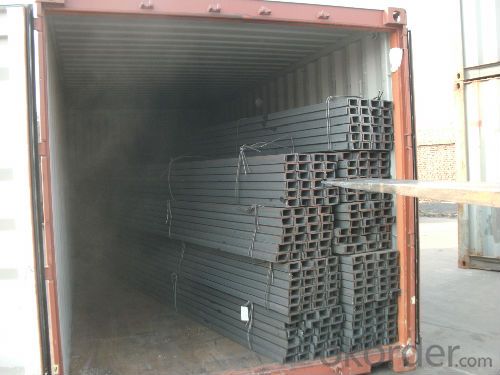
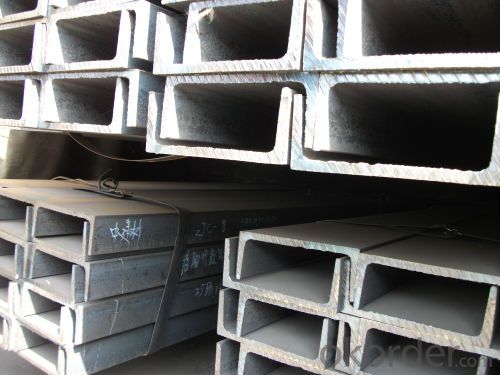
- Q: Are steel channels suitable for use in storage racks?
- Yes, steel channels are suitable for use in storage racks. Steel channels are designed to provide structural support and strength, making them ideal for storing heavy items or materials on racks. They offer high load-bearing capacity, durability, and resistance to bending or warping, which ensures the stability and safety of the storage racks. Moreover, steel channels can be easily customized and adjusted to fit specific storage requirements, making them versatile for various storage applications. Overall, steel channels are a reliable and efficient choice for constructing storage racks.
- Q: What angles, angles and channels are used in general? Please try to be specificWhat are the shapes used in construction?
- Many, steel column, steel beam, steel roof truss, curtain wall steel skeleton, billboard skeleton, special door....
- Q: What are the factors to consider when selecting the appropriate steel grade for a channel?
- When selecting the appropriate steel grade for a channel, there are several factors to consider. These include the load and weight requirements of the channel, the environmental conditions it will be exposed to (such as humidity or corrosion), the desired level of strength and durability, and the cost constraints of the project. Additionally, factors like the channel's intended application, fabrication requirements, and any specific standards or regulations that need to be met should also be taken into account. Overall, the selection of the steel grade should align with the specific needs and specifications of the channel to ensure optimal performance and longevity.
- Q: How do steel channels contribute to energy-efficient lighting design?
- Steel channels can contribute to energy-efficient lighting design by acting as a conduit for electrical wiring, allowing for proper placement and control of lighting fixtures. They provide a sturdy and reliable structure for mounting and supporting lighting equipment, ensuring that the fixtures are positioned optimally for maximum light output and efficiency. Additionally, steel channels can help to dissipate heat generated by the lighting fixtures, preventing energy loss and prolonging the lifespan of the lighting system.
- Q: Are steel channels suitable for soundproofing purposes?
- Steel channels are not typically used for soundproofing purposes. While steel channels can be effective in providing structural support and stability, they are not designed to block or absorb sound. Soundproofing typically requires materials that can absorb or deflect sound waves, such as acoustic foam, mass-loaded vinyl, or soundproof drywall. These materials are specifically engineered to reduce the transmission of sound, while steel channels are primarily used for construction and support purposes. Therefore, if soundproofing is the primary goal, it is recommended to explore other materials specifically designed for this purpose.
- Q: How do steel channels contribute to the overall flexibility of a structure?
- Steel channels contribute to the overall flexibility of a structure by providing additional strength and support. These channels can be used to reinforce and stabilize various components of the structure, allowing it to withstand external forces and loads without compromising its integrity. Additionally, the flexibility of steel channels enables architects and engineers to design structures with greater versatility and adaptability, as they can be easily adjusted and modified to meet specific requirements or accommodate changes in the future.
- Q: Can steel channels be used for column supports?
- Yes, steel channels can be used for column supports. Steel channels are often used in construction for their strength and durability. They provide structural support and stability for columns by distributing the load evenly. Steel channels can be welded or bolted together to create a strong and rigid framework for the columns. Additionally, steel channels can be easily customized and cut to the desired length, making them suitable for various column support applications.
- Q: Can steel channels be used in the construction of retaining walls?
- Absolutely, retaining walls can incorporate steel channels. These durable and strong structural components are commonly utilized in a range of construction endeavors. When integrated into retaining walls, they offer enhanced reinforcement and stability. Whether employed as vertical or horizontal supports, steel channels effectively distribute the load and thwart soil erosion. Moreover, their resistance to weathering and corrosion makes them an ideal long-term choice for retaining walls. Nonetheless, it is crucial to factor in the project's unique design prerequisites and seek guidance from a structural engineer to guarantee the accurate size, spacing, and positioning of the steel channels.
- Q: What are the tolerances for steel channels?
- The tolerances for steel channels can vary depending on the specific manufacturing standards and requirements. However, in general, tolerances for steel channels typically include dimensions such as width, depth, and length, as well as straightness and twist. These tolerances ensure that the steel channels meet the desired specifications and can be effectively used in various construction and engineering applications.
- Q: Can steel channels be used in underground construction?
- Yes, steel channels can be used in underground construction. Steel channels are commonly used in underground construction projects such as tunnels, subway systems, and underground parking lots. They provide structural support and can withstand the challenges posed by the underground environment, including soil pressure and water infiltration.
Send your message to us
Channel Bar Hot Rolled Mild U Channel Steel Bars
- Loading Port:
- Tianjin
- Payment Terms:
- TT or LC
- Min Order Qty:
- 100 m.t.
- Supply Capability:
- 35000 m.t./month
OKorder Service Pledge
OKorder Financial Service
Similar products
Hot products
Hot Searches
Related keywords
